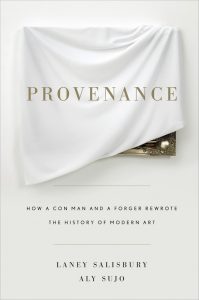Provenance by Laney Salisbury and Aly Sujo, USA, 2009
This is a true story about one of the twentieth century’s biggest and boldest art frauds. Although factual, it reads like a thriller, is well written and is definitely to be recommended.
John Drewe, with a number of aliases from John Cockett to Mr Carnall, is debonair, intelligent and well-spoken; he is also a formidable confidence man. While amazed by his ability not only to keep several steps ahead of the art establishment but also to keep so many balls in the air at the same time, I often found myself regretting that he did not turn his skills towards something positive and constructive, something on the right side of the law. His much greater-than-average intellectual capacity, his intimidating memory, his verbal aptitude and his magnetic personality propel him into a line of activity where he is motivated not so much by the prospect of monitory gain but more by the personal satisfaction of having set out to fool people and having succeeded.
Along the way, his activities impact extremely negatively on many people, both friends and strangers. For him, people are simply a means to an end, and he does not seem to mind losing friends or ruining people’s lives. He is completely focused on himself.
 Among those impacted are his art forger, John Myatt (who initially is not aware of what Drewe is doing with the paintings), his wife, Batsheva Goudsmid (who probably loses more than any one else) and his childhood friend Daniel Stoakes. Art dealers, art galleries, even a Roman Catholic monastic order, are all caught up in Drewe’s web before, thanks to a couple of sceptics and a couple of persistent detectives, it begins to unravel.
Among those impacted are his art forger, John Myatt (who initially is not aware of what Drewe is doing with the paintings), his wife, Batsheva Goudsmid (who probably loses more than any one else) and his childhood friend Daniel Stoakes. Art dealers, art galleries, even a Roman Catholic monastic order, are all caught up in Drewe’s web before, thanks to a couple of sceptics and a couple of persistent detectives, it begins to unravel.Towards the end of the book the following question is posed: what is it that makes an artwork a valuable work of art? Should the forger’s impeccable paintings be regarded as ‘works of art’ or does the fact that they are copies negate that possibility? When we read of Michelangelo forging several artworks and Picasso signing a work painted by someone else, we probably have to admit that, like most things today, the value of a work of art is dictated purely and simply by commercial interests.
 It would be nice to think that Drewe was snubbing his nose at an art world where money has taken precedence over motive and inspiration; however, I doubt very much that Drewe was motivated by such high aspirations. For him it was just a game.
It would be nice to think that Drewe was snubbing his nose at an art world where money has taken precedence over motive and inspiration; however, I doubt very much that Drewe was motivated by such high aspirations. For him it was just a game.Informative, thrilling, sad and, at times, frustrating, Provenance leaves us with many disparate thoughts and ideas.
Photos of the authors are from Laney Salisbury
